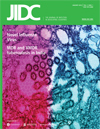Use of the cefepime-clavulanate ESBL Etest for detection of extended-spectrum beta-lactamases in AmpC co-producing bacteria
DOI:
https://doi.org/10.3855/jidc.493Keywords:
Antimicrobial resistance, AmpC beta-lactamase, ESBL Etest, Extended-spectrum -lactamasesAbstract
Background: Extended-spectrum beta-lactamases (ESBLs) may not always be detected in routine susceptibility tests. This study reports the performance of the cefepime-clavulanate ESBL Etest for the detection of ESBLs in Enterobacteriaceae, including those producing AmpC enzyme.
Methodology: Consecutive non-duplicate isolates of Escherichia coli, Klebsiella pneumoniae, and Proteus mirabilis isolated from bloodstream infections from January to June 2008 were tested for ESBL by both the standard CLSI double-disk diffusion method using ceftazidime and cefotaxime disks and Etests using ceftazidime/ceftazidime-clavulanate, cefotaxime/cefotaxime-clavulanate and cefepime/cefepime-clavulanate gradients. Isolates were also tested for the presence of transferable AmpC beta-lactamase by AmpC disk test and the efficacies of the different Etests in detecting ESBL production were compared.
Results: A total of 113 bacterial isolates (61 K. pneumoniae, 50 E. coli, and 2 P. mirabilis) were recovered. Respectively, 42 (37.2%) and 55 (48.7%) isolates were positive for ESBL by the ceftazidime-clavulanate and cefotaxime-clavulanate combined disk tests. The cefepime/cefepime-clavulanate Etest strip detected the maximum number of isolates (70/113, 61.9 %) as ESBL-positive compared to the ceftazidime/ceftazidime-clavulanate and cefotaxime/cefotaxime-clavulanate strips, which detected 57 (50.4%) isolates each as ESBL-positive. All three ESBL Etest strips were equally effective in detecting ESBL in the isolates that were AmpC negative. In the 66 (58.4%) isolates that co-produced AmpC in addition to the ESBL enzymes, cefepime/cefepime-clavulanate Etest strip detected ESBL in an additional 13 (11.4%) isolates as compared to the other ESBL Etest strips.
Conclusions: Cefepime-clavulanate ESBL Etest is a suitable substitute to test for ESBL production, especially in organisms producing AmpC beta-lactamases.Downloads
Published
How to Cite
Issue
Section
License
Authors who publish with this journal agree to the following terms:
- Authors retain copyright and grant the journal right of first publication with the work simultaneously licensed under a Creative Commons Attribution License that allows others to share the work with an acknowledgement of the work's authorship and initial publication in this journal.
- Authors are able to enter into separate, additional contractual arrangements for the non-exclusive distribution of the journal's published version of the work (e.g., post it to an institutional repository or publish it in a book), with an acknowledgement of its initial publication in this journal.
- Authors are permitted and encouraged to post their work online (e.g., in institutional repositories or on their website) prior to and during the submission process, as it can lead to productive exchanges, as well as earlier and greater citation of published work (See The Effect of Open Access).








